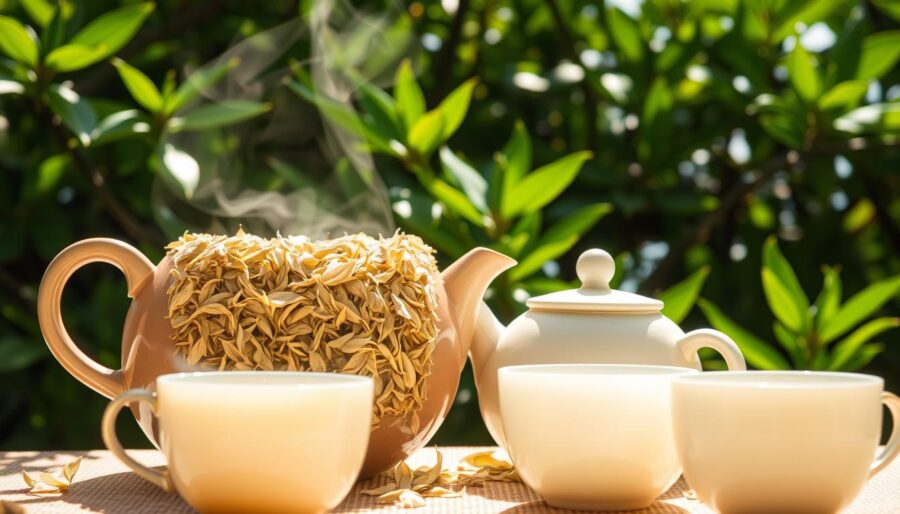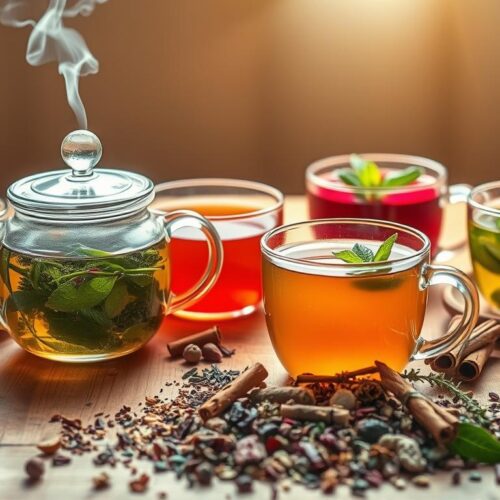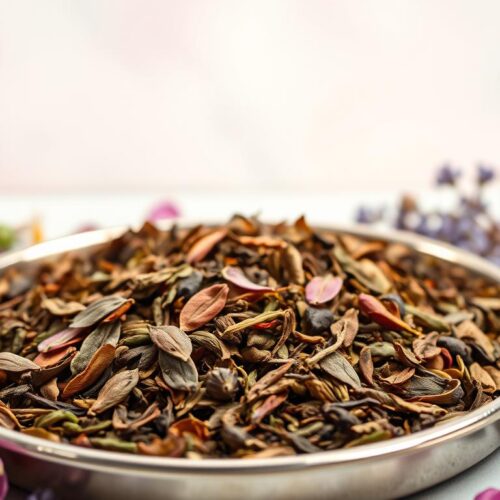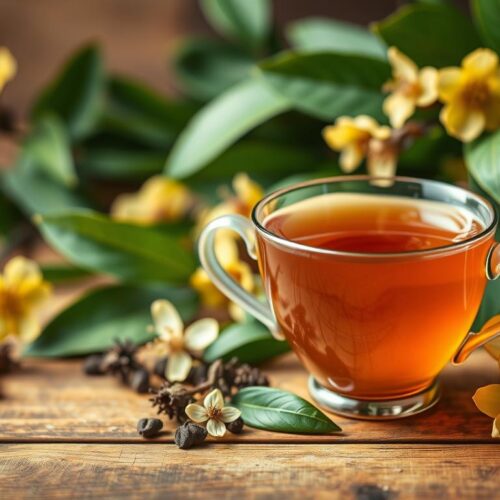White tea strikes a perfect balance. It calms you down while keeping you alert. It’s made from the freshest Camellia sinensis buds and leaves. Because it’s lightly handled, it tastes pure and subtle. Plus, it’s full of antioxidants. These include catechins and EGCG, which are great for your health.
White tea comes from places like Fujian, China, and Darjeeling. Here, farmers carefully dry the leaves to keep them fresh. Silver Needle and White Peony teas are light and slightly sweet. They only have 15–30 mg of caffeine per cup. This means you get a gentle boost of energy without feeling shaky.
Darjeeling White Tea grows high in the Himalayas. It’s packed with healthy compounds and has a unique flavor. Brewing it at lower temperatures keeps its delicate qualities. It also preserves the antioxidants. These are linked to heart health, calm skin, and a strong immune system.
Enjoying white tea can become a soothing daily habit. Its subtle boost, delicious taste, and history make it special. Drinking white tea is a way to relax, sip thoughtfully, and feel the power of a pure tea.
What is White Tea?
White tea started in China’s Fujian province, becoming a tradition during the Tang and Song eras. Local masters would let young tea buds dry under the sun. This method created a delicate tea, loved for its clear taste and gentle scent.
This tea is the least processed kind. It’s made from young buds and leaves picked in spring. The gentle drying process keeps its flavor light and its color pale. You’ll find the tea has a sweet finish, thanks to the careful way it’s made.
There are two main types of white tea. Silver needle white tea is known for its floral, sweet flavor. Bai mu dan, or White Peony, mixes buds and leaves for a fuller taste. Outside China, Darjeeling white tea brings a unique taste from the Himalayas.
For the best experience, choose organic, loose-leaf white tea. Use cooler water for brewing. This helps the tea’s delicate flavors and aromas stand out more with each sip.
| Origin | Style | Leaf/Bud Makeup | Flavor Profile | Why It Matters |
|---|---|---|---|---|
| Fuding, Fujian, China | Silver Needle White Tea (Baihao Yinzhen) | Pure spring buds with silvery hairs | Floral, honeyed, airy sweetness | Iconic delicate tea showcasing pristine buds |
| Zhenghe, Fujian, China | Bai Mu Dan (White Peony) | Bud plus one to two young leaves | Melon-like notes, light florals, soft body | Balanced cup with added depth and gentle texture |
| Darjeeling, India | Darjeeling White Tea | High-elevation buds and leaves | Misty, crisp, muscatel-leaning nuance | GI-protected terroir expresses cool Himalayan climate |
| Fujian tradition | Least Processed Tea Method | Hand-plucked, withered, lightly dried | Pale liquor, clean finish, subtle aroma | Preserves more native catechins and fresh character |
Exploring white tea’s different types—like the pure silver needle or the nuanced bai mu dan—connects you to its rich history. This history is shaped by traditional methods and gentle processing.
Rich in Antioxidants
When you choose white tea, you unlock a special source of tea antioxidants. This tea is the least processed kind. Its minimal oxidation keeps polyphenols like catechins, including EGCG, safe. These compounds fight off free radicals and reduce oxidative stress in your body.
Young tea buds bring in extra vitamins, such as vitamin C found in Darjeeling White Tea. Together, these elements blend perfectly. They support your health while keeping the tea’s flavor light and pure, offering a one-of-a-kind tea experience.
Choosing high-quality tea is crucial. Organic, loose-leaf teas from reputable brands like Harney & Sons, Rishi Tea, and Teavana are best. They help preserve the sensitive catechins. Brew your tea at 160–185°F and avoid steeping it too long. This way, you protect the tea’s gentle flavors and keep its antioxidants strong.
| Aspect | What It Means for You | Why White Tea Excels |
|---|---|---|
| Polyphenol Density | More tea antioxidants supporting cellular balance | Least processed tea preserves EGCG and other catechins |
| Oxidative Stress | Lower exposure to free radical damage | Minimal oxidation keeps protective compounds intact |
| Heart Markers | Support for healthy vessels and balanced LDL | Research on catechins links to improved endothelial function |
| Immune Support | Added shield during daily challenges | Synergy of catechins with vitamins from young buds |
| Flavor & Purity | Clean taste that’s easy to sip all day | Delicate tea character without heavy tannins |
| Brewing Care | Consistent white tea benefits in every cup | 160–185°F water and shorter steeps protect fragile compounds |
- Choose organic, loose-leaf to capture peak tea antioxidants.
- Heat water to 160–185°F and steep lightly for a delicate tea profile.
- Store away from light and air to sustain white tea benefits.
Promotes Healthy Skin
Drinking delicate tea made from young buds gives your skin a visible glow from inside. The antioxidants in tea, like catechins and polyphenols, calm inflammation inside your body. This results in softer, less red skin, showing how white tea is good for your skin.
Darjeeling White Tea is special because it has gentle caffeine that boosts circulation without being too harsh. This improved circulation helps with skin renewal, and L-theanine keeps your mood steady. As your stress levels drop, skin problems often do too, enhancing the improvements you see every day.
The sun can really age your skin. But, the antioxidants in tea fight against damage caused by UV rays, keeping your skin looking young. And those young tea buds? They’re packed with vitamin C and catechins, adding more protection for your skin.
You don’t just have to drink the tea; you can also apply it to your skin. Use cooled tea as a toner or mix it into a face mask for a soothing touch. This complements the benefits of drinking white tea, providing care that supports but doesn’t replace sunscreen.
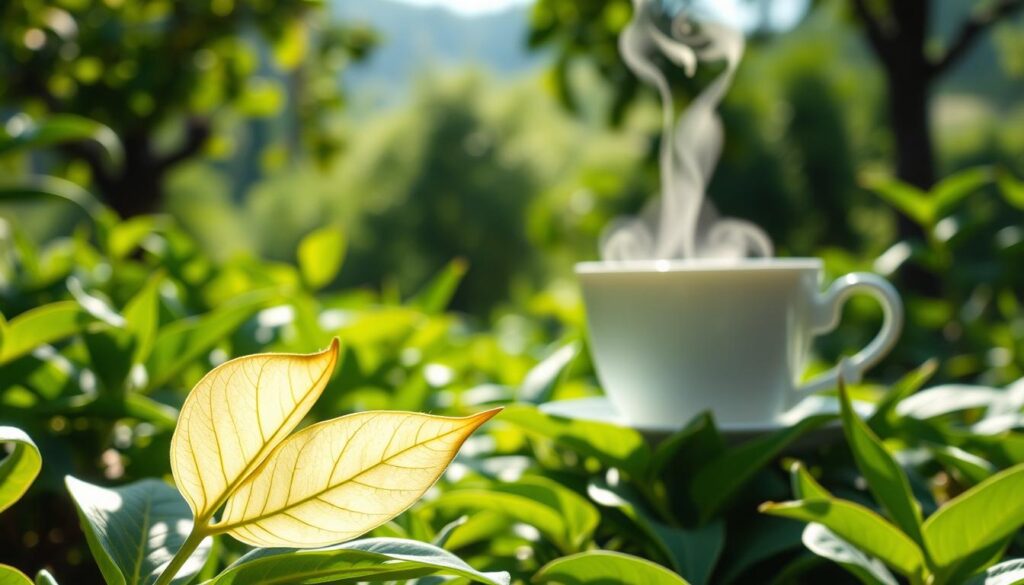
| Focus | How It Helps Skin | Key Compounds | Practical Tip |
|---|---|---|---|
| Inflammation Calm | Reduces redness and blotchiness for a clearer look | Catechins, polyphenols from tea antioxidants | Sip delicate tea daily to support even tone |
| Circulation & Renewal | Supports nutrient delivery and fresh appearance | Gentle caffeine in Darjeeling White Tea | Enjoy a morning cup for steady energy and glow |
| UV Defense Support | Helps counter free radicals linked to sun exposure | Vitamin C in young buds, catechins | Pair with SPF for daytime protection |
| Stress Balance | Fewer stress breakouts and calmer skin | L-theanine plus low caffeine | Choose evening delicate tea to unwind |
| Topical Soothe | Cools and tones after cleansing | Antioxidant-rich infusion | Use cooled brew as a toner or mask base |
Creating a routine with delicate tea brings many small, consistent benefits. The balanced caffeine, tea antioxidants, and purity of young leaves all help. Together, they support your skin’s calmness, clarity, and gentle glow over time.
Supports Weight Loss Efforts
White tea can support your weight loss plan with a gentle boost. It contains 15–30 mg of caffeine and L-theanine. This mix keeps you alert and active, helping with exercises and daily activities.
Being the least processed, white tea saves more health goodies, like EGCG. These help burn fat. Studies show white tea can assist in breaking down existing fat and reduce new fat formation. You’ll see the best results by combining it with healthy eating and exercise.
To make the most of it, brew it right. Heat water to 160–185°F and steep for 2–3 minutes. Keeping the right leaf-to-water ratio ensures you don’t lose any benefits. Don’t over-steep, and try it plain or with lemon to keep it low-calorie.
- Timing: Drink it 30–60 minutes before exercise for energy without the shakes.
- Frequency: Drinking 2–3 cups daily helps you stay hydrated and enjoy its benefits.
- Quality: Pick the freshest, least processed tea from trusted brands like Harney & Sons or Rishi for maximum antioxidants.
May Improve Heart Health
Adding white tea to your routine can quietly support your heart. Its antioxidants, like catechins, help your arteries work well. This can lead to lower bad cholesterol levels and improved blood vessel health.
Darjeeling White Tea is known for its high polyphenol content. These polyphenols assist in keeping blood vessels flexible, which is great for blood pressure. Plus, it’s low in caffeine, so you can enjoy it without feeling jittery.
Opt for organic white tea to steer clear of contaminants. Brew it lightly to enjoy its delicate flavor and full antioxidant benefits. Make white tea a part of your healthy lifestyle for the best results.
- Best times: morning or early afternoon for a calm, steady lift
- Pairings: citrus slices for extra vitamin C to support polyphenol absorption
- Serving tip: 160–175°F water, 2–3 minutes to protect fragile compounds in white tea
| Heart-Smart Focus | How White Tea Helps | Notable Variety | Everyday Tip |
|---|---|---|---|
| LDL Management | Catechins bind and limit oxidation, a step linked to artery health and white tea benefits | Silver Needle (Baihao Yinzhen) | Enjoy 2–3 cups per day as part of a balanced diet |
| Endothelial Function | Tea antioxidants support nitric oxide activity and vessel flexibility | Darjeeling White Tea | Keep hydration steady to aid circulation |
| Blood Pressure Support | Gentle vasodilation may ease daily pressure swings | White Peony (Bai Mudan) | Limit added sugar; taste the natural sweetness of white tea |
| Clean Sourcing | Organic picks reduce exposure to contaminants | USDA Organic–labeled options | Store leaves airtight, away from heat and light |
Enhances Mental Clarity
White tea gives you a smooth boost in focus. It’s got low caffeine and natural L-theanine. These help you stay alert and calm without feeling jittery. Many find it’s best when they need to think clearly for work, planning, or being creative.
When you make it, it’s a moment to be mindful. Heat water to 160–185°F (70–85°C) and let it steep for 2–4 minutes. Its light, floral taste makes you slow down, breathe, and clear your mind for what’s next.
Try white tea in the afternoon instead of coffee. It helps lower stress and doesn’t mess with your sleep. It provides a gentle boost that keeps you alert for late work or long drives but lets you wind down easily at night.
In Fujian, where white tea comes from, people connect it with calm and thoughtfulness. This tradition fits well with how we use it today—to take a quiet moment to sort our thoughts and regain focus.

| Aspect | White Tea | Typical Coffee | What It Means for You |
|---|---|---|---|
| Caffeine per 8 oz | 15–30 mg | 80–120 mg | White tea offers a smoother rise in focus with fewer jitters. |
| Key Amino Acid | L-theanine (calm focus) | Minimal L-theanine | More balanced attention and less mental noise. |
| Flavor Profile | Light, floral, delicate tea | Bold, bitter | Encourages mindful sipping that supports clarity. |
| Best Use Case | Deep work, reading, evening study | Short bursts of energy | White tea benefits sustained concentration without a crash. |
| Sleep Impact | Less likely to disrupt sleep | May delay sleep onset | Better for late-day focus with an easier wind-down. |
For a focused routine, brew a fresh cup before detailed work or to stay calm. Keep teas like Silver Needle or White Peony ready. Let white tea guide your day’s pace.
Follow a simple plan: heat, steep, sip, and then note how you feel. In a week, you’ll notice how white tea sharpens your focus smoothly, without the downsides of stronger drinks.
Aids in Digestion
If you want a drink that is easy on your stomach, go for white tea. This tea is light, not too bitter, and has a little caffeine, making it a stress-free choice. Plus, it helps some people with minor stomach upsets after eating.
Its antioxidants and anti-inflammatory benefits can soothe your gut. To avoid burning the tea and making it too bitter, keep the water between 160–185°F (70–85°C). Use clean water and let the leaves spread out in a gaiwan or basket infuser for a better taste.
Choosing loose-leaf Silver Needle or Bai Mu Dan can give you a mild, pleasant cup. Begin by steeping it briefly – 2 to 4 minutes first – to keep tannins low. Or you can cold brew it for 6–8 hours for a smoother taste, perfect for enjoying with meals or as a calming end to your meal.
When brewed thoughtfully, white tea consistently offers its benefits without making you feel full. It’s great for mornings, breaks in the afternoon, or light dinners when you need a tasty drink that’s gentle on your digestive system.
| Brew Method | Temp / Time | Digestive Focus | Tea Types | Practical Tips |
|---|---|---|---|---|
| Hot Infusion | 160–185°F, 2–4 min first steep | Soft mouthfeel; less astringency | Silver Needle, Bai Mu Dan | Use filtered water; pre-warm cup; avoid boiling water on leaves |
| Multiple Short Steeps | 3–5 resteeps, 30–90 sec each | Smoother extraction; steady comfort | Gongfu-style white teas | Let leaves expand fully in a gaiwan or basket infuser |
| Cold Brew | Fridge, 6–8 hours | Lower tannins; ultra-gentle on the stomach | Delicate tea with downy buds | Use spring or filtered water; strain well for a clear finish |
| Food Pairing | With light meals | Helps prevent bloating and discomfort | White blends with jasmine or pear | Sip warm, not scalding; small cups to pace digestion |
Strengthens the Immune System
When seasons change, your body can feel stressed. A cup of lightly processed tea can help. The young buds in premium white tea are rich in polyphenols and vitamin C. These boost your defenses while being gentle. And there’s less caffeine than in other teas.
Tea’s antioxidants, like catechins, reduce stress on immune cells. This helps your body fight off everyday germs better. Choosing organic leaves from places like Darjeeling or Fujian means a purer tea aligning with health goals.
Drinking high-quality white tea more than once can increase intake of protective stuff. Brew it lightly, then make it again to keep the taste and benefits. It’s a peaceful habit for those with little time.
Drink it daily for best results: stay hydrated, add citrus or berries, and avoid too much sugar. This routine boosts the benefits of white tea, keeping energy and focus steady.
| Immune-Support Factor | How It Helps | Practical Tip | Why White Tea |
|---|---|---|---|
| Polyphenols & Catechins | Reduce oxidative load on immune cells | Steep 2–3 minutes to preserve delicate compounds | High tea antioxidants in the least processed tea |
| Vitamin C in Young Buds | Supports barrier function during cold snaps | Add a slice of lemon after brewing | White tea benefits include gentle, natural vitamins |
| Multiple Infusions | Sustains steady intake without excess caffeine | Re-steep leaves 2–3 times through the day | Loose-leaf quality releases tea antioxidants gradually |
| Organic Sourcing | Minimizes exposure to synthetic residues | Look for USDA Organic on trusted brands | The least processed tea keeps the cup clean and light |
How to Brew Perfect White Tea
To get the best cup, use gentle heat and short time. For white tea, use water that’s 160–185°F (70–85°C). To keep silver needle white tea sweet and silky, keep it near 160°F (70°C). Darjeeling White Tea is best around 75–80°C to keep it from getting bitter.
Begin with a 2–4-minute steep for the first pour. If it’s Darjeeling, aim for 3–4 minutes but taste it at 3. You can steep it a bit longer with each following pour. High-grade bai mu dan and similar teas can be steeped 3–5 times, bringing out florals and honey.
Use 1–2 teaspoons of tea for every 8 oz of filtered water. A gaiwan, glass teapot, or a spacious basket infuser is perfect for letting the leaves expand. Keep your tea in a dark, airtight container to keep it fresh and flavorful.
To fully enjoy the tea’s delicate flavors like pear, melon, and hay, drink it plain. If you like, add a little lemon slice or some raw honey. For a refreshing, low-tannin drink, try cold brewing it in the fridge for 6–8 hours. Just strain it and enjoy over ice.
| Tea Type | Leaf Ratio (per 8 oz) | Water Temp | First Steep Time | Flavor Notes | Re-Steeps | Best Tools |
|---|---|---|---|---|---|---|
| Silver Needle White Tea | 1.5–2 tsp | 160°F (70°C) | 2–3 min | Silky, floral, honey | 3–5 | Gaiwan, glass teapot |
| Bai Mu Dan (White Peony) | 1–2 tsp | 170–180°F (75–82°C) | 2–4 min | Peach, melon, hay | 3–4 | Basket infuser, gaiwan |
| Darjeeling White Tea | 1–1.5 tsp | 75–80°C (just below boiling) | 3–4 min | Grape skin, floral, herb | 2–3 | Glass teapot, basket infuser |
| Cold Brew White Tea | 2 tsp | Cold, filtered | 6–8 hours | Crisp, low-tannin, sweet | — | Pitcher with fine strainer |
Conclusion: Embrace the Benefits of White Tea
White tea offers a gentle path to feeling good every day. It keeps in more antioxidants that protect your cells. These antioxidants help keep your skin looking young. They also support a healthy heart. Research shows white tea might lower bad cholesterol and improve blood flow. With less caffeine, it can make you feel alert but calm, perfect for focusing. Plus, it’s gentle on your stomach.
Choose your white tea based on where it comes from. From Fujian, Silver Needle has a delicate, flowery sweetness. Bai Mu Dan offers a richer taste with a hint of pear. Darjeeling White Tea gives a unique mineral taste because of its high-mountain origin. Try different types to enjoy various tastes and health benefits all week.
When making white tea, do it with respect for its gentleness. Heat water to 160–185°F and let it steep for 2–4 minutes. You can use the leaves again 3–5 times to get more out of them. It’s best to go for organic, loose-leaf tea. Store it right to keep it fresh for 6–12 months. It goes well with seafood, soft cheeses, or sweet fruit desserts.
Let white tea become a part of your daily habits. Start your day calmly with it, replace your afternoon coffee for a focused feeling, and end your night with it to avoid caffeine before bed. By making it a regular part of your day, you’ll see improvements in your skin, heart, immune system, digestion, and mind.

